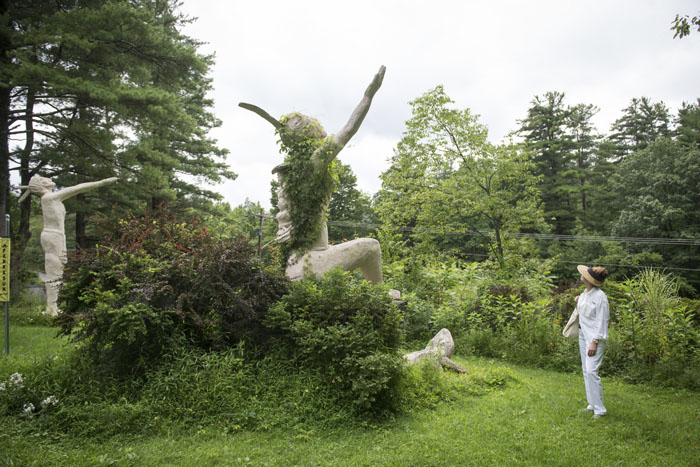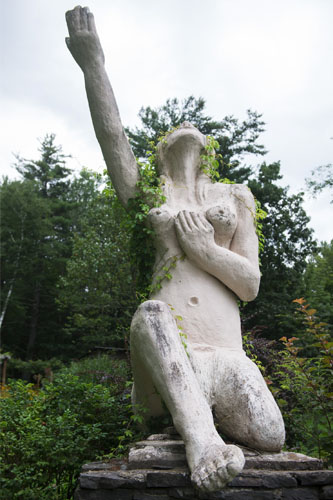
(Photos by Dion Ogust)
According to best-selling author Neil Gaiman – a transplant from England who now lives part of the year in Ulster County – a large part of the inspiration for his fantasy novel American Gods (recently turned into a Starz cable TV series) came from his fascination with “roadside attractions.” There’s something quintessentially American about these imaginative phenomena that popped up all over the country as its highway system spread in the mid-20th century; apparently the Old World doesn’t really have anything comparable. Is it our romance with the automobile, or merely our lack of cultivated taste that accounts for their proliferation on this side of the Pond?
 For Gaiman, the spark came from a gigantic sculpture of a cheese somewhere in the Upper Midwest. But New York State certainly has its share of roadside oddities. Growing up on Long Island, this correspondent spent much of her summers at the beach on Napeague Bay, near Montauk, where my grandparents kept a little Airstream camper. No road trip out to the East End was complete without visits to the Big Duck, near Riverhead, or the 12-foot-tall painted concrete statues of dueling musketeers at the Casa Basso restaurant in Westhampton. Similarly odd tourist attractions could readily be spotted in places like Lake George and Old Forge in the Adirondacks. They weren’t high art, perhaps; but for a small child, they were magical friends.
For Gaiman, the spark came from a gigantic sculpture of a cheese somewhere in the Upper Midwest. But New York State certainly has its share of roadside oddities. Growing up on Long Island, this correspondent spent much of her summers at the beach on Napeague Bay, near Montauk, where my grandparents kept a little Airstream camper. No road trip out to the East End was complete without visits to the Big Duck, near Riverhead, or the 12-foot-tall painted concrete statues of dueling musketeers at the Casa Basso restaurant in Westhampton. Similarly odd tourist attractions could readily be spotted in places like Lake George and Old Forge in the Adirondacks. They weren’t high art, perhaps; but for a small child, they were magical friends.
The mid-Hudson Valley offers its own variety of postcardworthy destinations. Some are easy to spot, like the giant Prozac capsule and the Fork in the Road sculpture in Dutchess County, or Gnome Chomsky at Kelder’s Farm in Kerhonkson. Others take a bit more hunting, such as the cliffside petroglyphs carved and painted by Zadock Pratt in Prattsville.
In the case of the Emile Brunel Studio and Sculpture Garden in Boiceville, the site was a major roadside attraction before World War II. Then known as Le Chalet Indien resort, it became the summer home of Harold Prince and Max Ernst; regular visitors included Enrico Caruso, George M. Cohan, Edward VIII and Wallis Simpson. Proprietor Emile Brunel counted Franklin D. and Eleanor Roosevelt among his personal friends.
Then Route 28 got widened and relocated, Brunel died and the property, once approaching 80 acres in size was broken up. A pioneering photographer born in Châteauneuf, France, Brunel had come to the US in 1904 and traveled through the Western states, where he became fascinated with Native American cultures. After settling in Boiceville in 1918, he began adorning his property with sculptures inspired by indigenous art (though somewhat lacking in authenticity or artistic sophistication). Beginning with a wire mesh core filled with rocks, then covering them with concrete, he crafted totem poles, animal figures and statues of a standing Native man (30 feet in height) and kneeling woman.
Seven of the surviving sculptures have been consolidated onto a smaller parcel of land, where Brunel’s Arts and Crafts-style former home and studio – adorned with carved bas-reliefs, also Indian-themed – still stands. In recent decades, the site has been named to the National Register of Historic Places and a collapsed totem pole sculpture restored. Yes, you can pay a visit: The Emile Brunel Studio and Sculpture Garden are located on Da Silva Road, just off Route 28 in Boiceville. To learn more, start with http://bit.ly/2vWpiXf. A description of the statues for self-guided tours is available from the owners. If you knock on their door, they’ll also provide you with a detailed Ulster Publishing article about the site and its origins.

